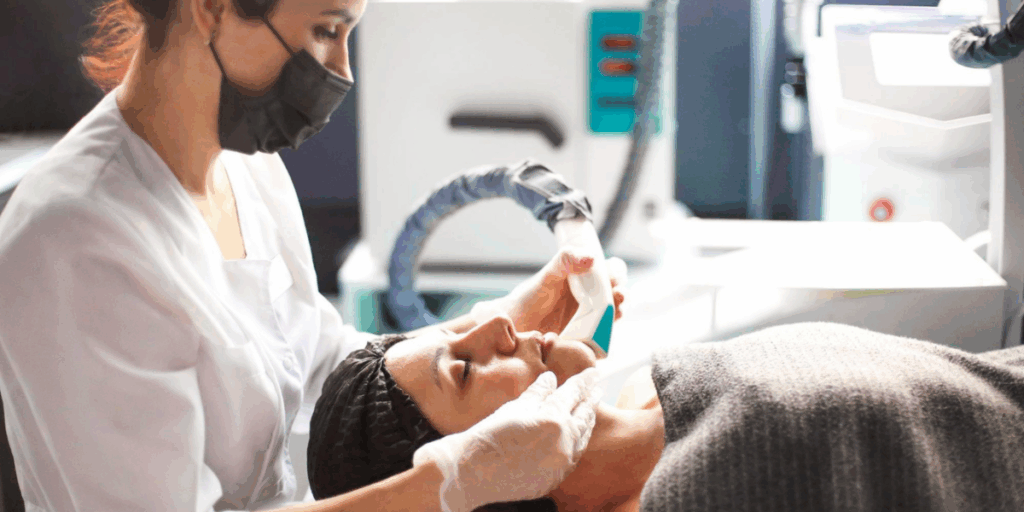

Quick Summary
When we mention doctors, we often mean general physicians who offer non-surgical treatment. How to Become a Dermatologist: Doctors include a wide range of specialties to treat different diseases. For instance, people consult oncologists, not general surgeons, for cancer treatment. Likewise, to deal with skin-related diseases, people need a specialist called a dermatologist.
Dermatologists are doctors who pursue “Dermatology”, a field of study that involves skin, hair, and nails. The responsibility of Dermatologists is to treat skin-related diseases, including less aggressive skin cancer. Dermatologists are also considered surgeons as they perform surgeries while treating skin cancer.
A popular dermatology surgeon is called a Mohs surgeon. In addition to clinical practice, there are numerous dermatology research opportunities available, allowing dermatologists to contribute to advancements in the field. These research opportunities can focus on various aspects, such as innovative treatments, understanding skin conditions, and improving surgical techniques, ultimately enhancing patient care and outcomes in dermatology.

How to Become a Dermatologist: Occasionally, it is the responsibility of dermatologists to perform testing of new drugs. If you want to help people with their skin health, you can pursue this career path. This article will help you get started on how to become a dermatologist. Here we provide you with a step-by-step guide on how to become a dermatologist in India.
Dermatologists are medical professionals who specialize in diagnosing and treating conditions related to the skin, hair, nails, and mucous membranes. They handle a wide range of issues, including acne, eczema, psoriasis, skin infections, allergies, and hair loss. Dermatologists also perform cosmetic procedures like laser treatments, Botox, fillers, and chemical peels to enhance skin appearance.

In addition, they conduct skin cancer screenings, perform biopsies, and treat serious conditions like melanoma. Some dermatologists specialize in pediatric dermatology, dermatopathology, or cosmetic dermatology, depending on their expertise. Their role is crucial in both medical and aesthetic skin health, helping patients maintain healthy and problem-free skin.
As most people think, dermatology is not a tiny field. Dermatology itself is vast and includes different dermatology specialities. And if you want to know how to become a dermatologist you must know about specific specializations focusing on skin, hair, or nails. Here is a list of some common dermatologist types:
Now, let’s have a closer look at each type of dermatologist. It elaborates on the education and skills needed.

Cosmetic dermatology is a field focusing on enhancing the way patients look. They often specialize in specific areas that include assessing patients for skin cancer. They perform surgeries on patients according to the treatment plan.
Job description: Cosmetic dermatologists perform surgery to enhance the appearance of patients. They also perform hair removal and assess patients for skin cancer.
Educational Qualification: Bachelor’s or Master’s Degree in Dermatology (any relevant field)
Average Salary: Rs. 4.0 LPA

The field of dermatopathology studies the origin of certain skin diseases. Dermatopathologists undergo pathology training to determine where the skin disease comes from. They work with cosmetic dermatologists to get samples to determine the disease’s origin.
Job description: Dermatopathologists assess the skin samples to determine the disease’s origin. They also determine the nature of the skin disease and offer help as requested.
Educational Qualification: Bachelor’s or Master’s Degree in Dermatology (any relevant field).
Average Salary: Rs. 5.6 LPA

Immunodermatology studies the relationship between the immune system and the skin. They often deal with skin diseases that are associated with the patient’s immune system. Immunodermatologists perform trials to determine the reaction of the skin to different substances.
Job description: Immune Dermatologists treat skin diseases that affect patients’ immune systems.
Educational Qualification: Bachelor’s or Master’s Degree in Dermatology (any relevant field).
Average Salary: Rs. 4.8 LPA

These are dermatology specialists who treat skin cancer with the help of Mohs surgery. How to Become a Dermatologist: Mohs surgeons perform these surgeries to treat skin cell-related cancers. This surgery will remove the cancer cells layer by layer to prevent the spread. It treats skin cancers such as carcinomas (BCCs) and squamous cell carcinomas (SCCs).
Job description: Mohs surgeon treats skin cancer by performing Mohs surgery.
Educational Qualification: Bachelor’s or Master’s Degree in Dermatology (any relevant field)
Average Salary: Rs. 4.8 LPA


Pediatric dermatology is a specialization that deals with skin diseases related to children. The common skin treatment will have adverse reactions in babies and children. That’s why pediatric dermatologists help children with the right type of treatment.
Job description: Pediatric dermatologists treat children with skin diseases. They provide initial care for cognitive skin disease. They also assess the nature of the treatment for children.
Educational Qualification: Bachelor’s or Master’s Degree in Dermatology (any relevant field).
Average Salary: Rs. 3.5 LPA
Dermatologist salary are mentioned as per Ambitionbox. Figures may vary based on their location, experience, specialty.

How to Become a Dermatologist: Becoming a dermatologist in India requires exceptional educational qualifications and skills. Also, internships and residency in the field. If you want to know how to become a dermatologist, refer to the steps mentioned below:
How to become a dermatologist after the 12th? After completing the 12th standard, you can pursue an MBBS or a dermatology bachelor’s degree. Remember, you must opt for the science stream in the 12th standard.
To pursue an MBBS degree, you must clear the NEET exam. The National Eligibility Entrance Test (NEET) is a national-level entrance exam. Students must have the required cutoff in the NEET exam to pursue an MBBS in India. Thus, clearing the entrance exam becomes a part of how to become a dermatologist.
Once you complete the bachelor’s degree, you can pursue a master’s degree. You can opt for M.Sc in dermatology or pursue an MD (Doctor of Medicine). Completing your master’s degree gets you one step closer to becoming a dermatologist.
Internships are mandatory for all medical fields; dermatology is no exception. How to Become a Dermatologist: So another important step in how to become a dermatologist is completing a compulsory rotating internship. You need to join internships offered by credible hospitals. You can also complete your internship by choosing an MBBS degree at the undergraduate level.
How long does it take to become a dermatologist? It depends on the bachelor’s and master’s degrees you choose and how long you opt for internships. However, fulfilling all your education is not enough to become a dermatologist. As a final step in your journey, you must register with the Medical Council of India (MCI). Applying for a medical license is a crucial step on how to become a dermatologist. Because it is illegal to practice medicine without an MCI license.
After getting a medical license, apply for several certification courses. It doesn’t hurt to have extra prospects in the resume. You must be ready to learn in any way possible in this competitive field. Here is a list of some well-known certification courses:
How much time does it take to become a dermatologist? It takes an average of 11 years to become a dermatologist. But the time to achieve your goal will vary according to your chosen path. Below is a detailed outlook on how long it takes to become a dermatologist:
A dermatologist must have a deep understanding of skin, hair, and nail conditions. This includes identifying diseases, conducting medical tests, and diagnosing various dermatological issues.
Proficiency in performing skin biopsies, cosmetic procedures, and minor surgeries is crucial. Dermatologists should also be skilled in laser treatments, mole removals, and acne scar revisions.
Since dermatologists interact with diverse patients, clear communication and empathy are essential. They must explain diagnoses, treatment plans, and post-care instructions in an understandable manner.
Skin conditions can have subtle symptoms, requiring dermatologists to observe minute details. A keen eye helps in accurate diagnoses and ensures effective treatment plans.
For those running private clinics, knowledge of business management, patient handling, and medical billing is beneficial. Understanding how to market their practice also helps in career growth.
The dermatology field evolves with new treatments, techniques, and skincare innovations. Staying updated through research, workshops, and medical conferences ensures high-quality patient care.
Consulting a dermatologist is no different from consulting any other specialization. Just because it treats skin, nails, and hair doesn’t mean it isn’t important. People are always conscious of the way they look. This specialization helps them to maintain how they look by taking care of their skin.
But it doesn’t always involve the appearance of the patient. It also deals with life-threatening diseases such as skin cancer and leprosy. These merits of dermatology make it a field with promising career opportunities. Below are some of the great career opportunities for a dermatologist.
Private practices make a suitable career opportunity for dermatologists. Because it provides freedom and flexibility. However, it requires at least four years of residency experience in the field. Dermatologists can open their private practice based on their financial status. Establishing a private practice includes the following steps:
Most functioning hospitals and clinics need dermatologists. This knowledge of skin diseases makes it a valuable hospital. Hospitals hire a dermatologist with a high salary to provide comprehensive care. This demand in hospitals makes dermatologists a promising career. The hospitals’ salary range depends on education and experience.
Research and academics prove to provide great career opportunities for a dermatologist. Dermatologists have considerable opportunities to research new drugs and procedures. They can analyze skin disorders by trial and error. But they need to specialize in this field to be a research scholar. The research sector presents dermatologists with various lab positions, including:
Government sectors present dermatologists with excellent career opportunities. Dermatology students are recruited by various government hospitals and medical institutes right out of college. They also provide several internship programs. Some of the major roles of dermatologists in government sectors are listed here:
Becoming a doctor is not easy, let alone becoming a dermatologist. Once you decide to become a dermatologist, it is a long road ahead. After all, each speciality has its advantages and disadvantages. Dermatology offers interesting work as it studies various skin diseases and new drugs. It offers job security and work convenience. Most of the time, dermatologists consult by appointment. At the same time, earning a specialized degree takes years of study.
How to Become a Dermatologist: Being a dermatologist demands at least 11 years of study. The cost of pursuing a dermatology degree is high. But the years of studying get well compensated with a high salary. Don’t forget the entrance exams you must pass to get admission to credible institutes. But the years of studying get well compensated with a high salary. Thus, you must weigh your options and choose.
Evaluate numerous career choices to choose the right career path for yourself. Dive into our guide on Career Advice.
Yes, you can. After finishing BDS, you can choose B.SC. Dermatology to become a dermatologist. You can also pursue a diploma in dermatology after finishing a BDS. It is because the BDS has various short-term courses that are associated with dermatology. It also includes certified courses in cosmetic dermatology. So you can also pursue super specialization if you want.
The need to attend NEET depends on how you decide to pursue dermatology. You can opt for B.Sc. Dermatology or MBBS at the undergraduate level. If you decide to pursue MBBS, you need to attend NEET. MBBS covers a larger spectrum than B.Sc in dermatology. If you opt for MBBS, you can keep your choices wide open.
Yes, people find it difficult to study dermatology. But everything seems difficult until you choose to see otherwise. Also, the difficulty of dermatology increases as you pursue higher education. The difficulty of this field makes it suitable for students with ambitious goals. But make no mistake; it is also among the highest-paying fields providing a balanced lifestyle.
It takes an average of 11 years to become a dermatologist. Also, the time it takes to become a dermatologist is one of the reasons behind the high profile of a dermatologist. But it depends on the individual and other determining factors. Below is a list of some determining factors:
1. The course duration of an undergraduate degree,
2. Whether having a gap year,
3. Years of residency,
4. Duration of internship programs.
Yes, after completing MBBS in India, you can become a dermatologist by pursuing a postgraduate degree (MD in Dermatology). Admission to MD programs is based on entrance exams like NEET-PG. Alternatively, you can opt for a Diploma in Dermatology or a DNB (Diplomate of National Board) in Dermatology.

Authored by, Gagandeep Khokhar
Career Guidance Expert
Gagandeep is a content writer and strategist focused on creating high-performing, SEO-driven content that bridges the gap between learners and institutions. He crafts compelling narratives across blogs, landing pages, and email campaigns to drive engagement and build trust.
Editor's Recommendations
Chegg India does not ask for money to offer any opportunity with the company. We request you to be vigilant before sharing your personal and financial information with any third party. Beware of fraudulent activities claiming affiliation with our company and promising monetary rewards or benefits. Chegg India shall not be responsible for any losses resulting from such activities.
Chegg India does not ask for money to offer any opportunity with the company. We request you to be vigilant before sharing your personal and financial information with any third party. Beware of fraudulent activities claiming affiliation with our company and promising monetary rewards or benefits. Chegg India shall not be responsible for any losses resulting from such activities.